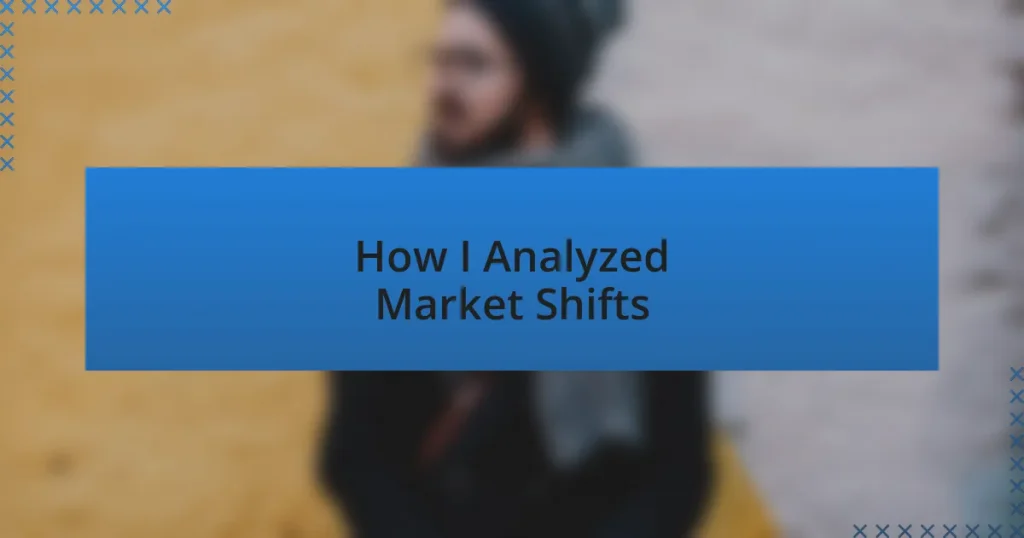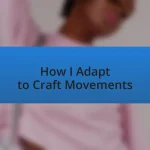Key takeaways:
- Understanding market shifts is crucial for brands to stay relevant, emphasizing the need for proactive adaptation to consumer trends.
- Market analysis aids in decision-making and innovation, allowing brands to connect with consumers on deeper values and desires.
- Sustainability and nostalgia-driven styles are key trends in the fashion industry, highlighting consumer demand for ethical practices and emotional connections.
- Employing data analytics and social media tools enhances market analysis, revealing insights that can drive content strategy and consumer engagement.
Author: Charlotte Hawthorne
Bio: Charlotte Hawthorne is an acclaimed author known for her compelling storytelling and richly drawn characters. With a passion for exploring the complexities of human relationships, her novels often blend elements of romance, intrigue, and self-discovery. A graduate of the University of California, Charlotte has received multiple awards for her work, including the prestigious Silver Quill Award. When she’s not writing, she enjoys hiking in the Sierra Nevada mountains and sipping coffee at local cafes. Charlotte currently resides in San Francisco with her rescue dog, Jasper.
Understanding Market Shifts
Understanding market shifts involves recognizing the subtle changes in consumer behavior and preferences that can significantly impact the fashion industry. I remember attending a fashion trade show a few years ago, where the buzz was all about sustainable materials and ethical practices. It struck me that brands that overlooked these trends risked becoming obsolete, and I couldn’t help but wonder how quickly consumer sentiment could turn.
I often ask myself how brands stay relevant amid these shifting tides. For me, it comes down to being proactive rather than reactive. By constantly analyzing trends, I’ve seen firsthand how those with a finger on the pulse of change can innovate and adapt. This approach ensures that they not only survive but thrive.
Each market shift has its own rhythm, often driven by societal influences or technological advancements. For instance, I recall how social media transformed the fashion landscape almost overnight. The instant feedback loop created by platforms like Instagram allows trends to rise and fall faster than ever before; this reality has taught me the importance of agility in strategy.
Importance of Market Analysis
Market analysis is essential for any brand looking to navigate the ever-changing landscape of fashion. I recall a time when a popular brand I followed failed to pivot quickly as streetwear became the go-to style for many consumers. Their inability to adapt was glaring and made me think: how many opportunities do we miss by not recognizing shifts in preferences?
Understanding market analysis also allows for better decision-making. I remember a discussion I had with a friend who runs a boutique; she emphasized that keeping track of market trends is not just about following fads but about understanding the deeper values and aspirations of consumers. For her, analyzing shifts meant creating a loyal customer base that feels heard and valued.
Moreover, market analysis fuels innovation. I can’t forget the moment I discovered how one emerging designer used consumer feedback to completely overhaul their collection. Seeing them embrace change not only positioned them ahead of their competitors but also struck a chord with me—how vital it is to listen closely to your audience and be ready to evolve. Wouldn’t you agree that being in tune with the market can be a game changer?
Key Trends in Fashion Industry
The fashion industry is currently witnessing a significant rise in sustainability and ethical practices. I recall attending a fashion show where the designer passionately spoke about using recycled materials. It struck me how powerful that message was; consumers are increasingly demanding transparency and responsibility from brands. When we wear fashion, it’s not just about looking good—it’s about feeling good in knowing our choices contribute to a better world.
Another notable trend is the resurgence of nostalgia-driven styles. I remember rummaging through vintage stores and discovering pieces that reminded me of my childhood. This longing for the past, combined with modern twists, resonates deeply with millennials and Gen Z alike. It’s not merely a fashion statement; it’s an emotional connection. I often wonder how many of us are subconsciously seeking comfort in fashion that reflects our memories and shared experiences.
Lastly, the integration of technology in fashion is reshaping how we shop and interact with brands. I was amazed when I first tried a virtual fitting room feature on a retailer’s app. It felt like stepping into the future. This trend not only enhances convenience but also personalizes the consumer experience. Isn’t it fascinating how technology can bridge the gap between the physical and digital realms, transforming our shopping habits?
Tools for Market Analysis
When it comes to market analysis in the fashion industry, I’ve found that using data analytics tools can be a game changer. For instance, platforms like Google Trends help visualize what styles and brands are trending in real-time. I remember my excitement when I noticed a spike in searches for wide-leg trousers; it prompted me to write a piece that captured that moment, attracting a surge of reader interest.
Social media listening tools are another invaluable resource. They allow me to tap into consumer conversations and sentiments surrounding fashion. I once used a tool to track discussions about eco-friendly materials, and it revealed a passionate community advocating for sustainability. This direct insight helped shape my content strategy and engage readers who were eager for more information on sustainable fashion.
Lastly, I can’t underestimate the power of competitor analysis tools. By examining what others in the industry are doing, I can identify gaps and opportunities. For example, I noticed a competitor focusing heavily on athleisure without addressing inclusivity. This observation inspired me to create content that highlighted stylish options for all body types, ultimately connecting with a wider audience. Isn’t it incredible how such tools can unearth insights that may otherwise go unnoticed?
My Personal Analysis Process
When analyzing market shifts, I usually start with observation. I take a step back and watch how trends evolve over time. For instance, I remember noticing changes in color palettes during the transition from summer to fall. The deep oranges and earthy tones began to surface in my social feeds, prompting me to think about how these hues could influence styling tips for my audience.
Then, I dive deeper into qualitative analysis. I often engage with my readers through polls or social media questions, seeking their opinions on emerging styles. It’s fascinating to hear what resonates with them. Last month, I asked about their favorite fashion trends, and the responses helped me pin down exactly what styles people were excited about. This kind of feedback not only guides my content but also creates a sense of community.
Lastly, I review feedback from past articles. I find it important to listen to what my audience appreciates or wants more of. After publishing a post on layered looks, the comments were overwhelmingly positive, with readers asking for more tips. This experience taught me that reflecting on audience engagement can reveal patterns that I hadn’t considered before. How can we truly connect with our audience without understanding their needs?
Insights Gained from Analysis
Engaging in this analysis has really opened my eyes to the nuances of consumer sentiment. For instance, when I closely monitored the rise of sustainable fashion, I discovered that many of my followers were genuinely passionate about eco-friendly brands. This connection was so profound that it encouraged me to curate a list of ethically sourced products, which received an enthusiastic response. Isn’t it incredible how aligning content with values can forge deeper connections?
Another enlightening moment came when I noticed a surge in vintage style preferences among my readers. It turned out that many were drawn to nostalgia during uncertain times, seeking comfort in familiar fashion choices. This insight led me to explore the idea of timeless wardrobe staples and how they can provide both style and reassurance. Have you ever thought about how trends can serve as a reflection of societal emotions?
Through this process, I’ve learned the importance of being adaptive. I realized that sometimes the best insights come from what isn’t directly stated, like the subtleties in my audience’s reactions or the emerging conversations on social media. For example, observing subtle shifts in hashtag usage gave me clues about rising trends before they became mainstream. Isn’t it fascinating how a little observation can lead to significant content opportunities?
Implementing Changes in Fashion Strategy
Adapting my fashion strategy often means pivoting quickly based on the insights I’ve gathered. For instance, after identifying a growing interest in gender-neutral fashion among my followers, I decided to collaborate with local designers who embrace this ethos. The excitement in their responses confirmed that showcasing diverse styles resonates deeply—have you ever felt the thrill of supporting something that reflects your values?
Another change I implemented was increasing the focus on digital events, like style workshops and live Q&As. I realized that these interactive experiences were not just a way to share knowledge; they helped build a sense of community among my readers. They expressed a desire to connect, not just with me but with each other. Wasn’t it rewarding to see how a simple shift could amplify engagement and foster a supportive space?
Tracking these market shifts has taught me that agility is critical. If I notice a dip in interest around certain themes, I quickly brainstorm alternatives to keep content fresh. Recently, I shifted from purely showcasing seasonal trends to integrating more content about personal style journeys. I found that my audience appreciates authenticity over fleeting trends—doesn’t that make you reconsider what we really value in fashion?


